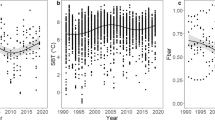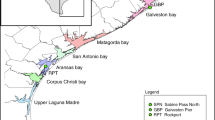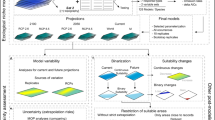Abstract
The increasing success of invasive warm water species is often explained as a direct consequence of a warming climate, but other environmental variables are seldomly taken into account. Here, running RandomForest models with many combinations of relatively uncorrelated environmental predictors, we investigate the factors influencing the distribution of Red Sea fishes in the Mediterranean Sea, which was invaded through the Suez Canal. Our results highlighted the fundamental role of salinity, not only temperature, in determining the distribution of these tropical species, with average values (primarily salinity and surface sea temperatures) performing the best of the respective groups. Noteworthy, models based on surface variables only resulted in higher evaluation scores than those including also bottom variables. These findings contribute to identifying the most relevant factors that explain tropical fish distribution in the Mediterranean Sea and provide advice to the selection of environmental variables in species distribution modeling.

Similar content being viewed by others
References
Assis J, Tyberghein L, Bosh S, Verbruggen H, Serrão EA, De Clerck O (2017) Bio-ORACLE v2.0: extending marine data layers for bioclimatic modelling. Glob Ecol Biogeogr 27:277–284
Azzurro E, Ben Souissi SJ, Boughedir W, Castriota L, Deidun A, Falautano M, Andaloro F (2014) The Sicily Strait: a transnational observatory for monitoring the advance of non-indigenous species. Biol Mar Med 21:105–106
Azzurro E, D’Amen M (2022) Climate change paves the way for a new inter-ocean fish interchange. Front Ecol Env 20:558–563
Azzurro E, Smeraldo S, Minelli A, D’Amen M (2022a) ORMEF: a Mediterranean database of exotic fish records. Sci Data 9:363
Azzurro E, Nourigat M, Cohn F, Ben Souissi J, Bernardi G (2022b) Right out of the gate: the genomics of Lessepsian invaders in the vicinity of the Suez Canal. Biol Inv 24:1117–1130
Bentlage B, Peterson AT, Barve N, Cartwright P (2013) Plumbing the depths: extending ecological niche modelling and species distribution modelling in three dimensions. Glob Ecol Biogeogr 22:952–961
Ben Rais Lasram F, Hattaba T, Noguesc Q, Beaugranda G, Dauvind JC, Halouanic G, Le Loc’h F, Niquil N, Leroy B (2020) An open-source framework to model present and future marine species distributions at local scale. Ecol Inform 59:101130
Bernardi G, Azzurro E, Golani D, Miller MR (2016) Genomic signatures of rapid adaptive evolution in the bluespotted cornetfish, a Mediterranean Lessepsian invader. Mol Ecol 25:3384–3396
Boeuf G, Payan P (2001) How should salinity influence fish growth? Comp Biochem Physiol 130C:411–423
Bosch S, Tyberghein L, Deneudt K, Hernandez F, De Clerck O (2018) In search of relevant predictors for marine species distribution modelling using the MarineSPEED benchmark dataset. Div Distr 24:144–157
Cheung WWL, Lam VWY, Sarmiento JL, Kearney K, Watson R, Pauly D (2009) Projecting global marine biodiversity impacts under climate change scenarios. Fish Fish 10:235–251
Coll M, Piroddi C, Steenbeek J, Kaschner K, Ben Rais Lasram F, Aguzzi J, Ballesteros E, Bianchi CN, Corbera J, Dailianis T, Danovaro R (2010) The biodiversity of the Mediterranean Sea: estimates, patterns, and threats. PLoS One 5(8):e11842
Cote IM, Green SJ (2012) Potential effects of climate change on a marine invasion: the importance of current context. Curr Zool 58:1–8
Cowen RK, Paris CB, Srinivasan A (2006) Scaling of connectivity in marine populations. Science 311:522–527
D’Amen M, Azzurro E (2020) Integrating univariate niche dynamics in species distribution models: a step forward for marine research on biological invasions. J Biogeogr 47:686–697
D’Amen M, Azzurro E (2020) Lessepsian fish invasion in Mediterranean Marine Protected Areas: a risk assessment under climate change scenarios. ICES J Mar Sci 77:388–397
D’Amen M, Smeraldo S, Di Franco A, Azzurro E (2022) The spread of Lessepsian fishes does not track native temperature conditions. ICES J Mar Sci 79:1864–1873
Duffy GA, Chown SL (2017) Explicitly integrating a third dimension in marine species distribution modelling. Mar Ecol pro Ser 564:1–8
Edwards FJ (1987) Climate and oceanography. In: Edwards AJ, Head SM (eds) Key environment Red Sea. Pergamon Press, Oxford, UK, pp 45–69
Emeis KC, Struck U, Schulz HM, Rosenberg R, Bernasconi S, Erlenkeuser H, Sakamoto T, Martinez-Ruiz F (2000) Temperature and salinity variations of Mediterranean Sea surface waters over the last 16,000 years from records of planktonic stable oxygen isotopes and alkenone unsaturation ratios. Palaeogeogr Palaeoclimatol Palaeoecol 158:259–280
Givan O, Edelist D, Sonin O, Belmaker J (2018) Thermal affinity as the dominant factor changing Mediterranean fish abundances. Glob Change Biol 24:e80–e89
Golani D (2010) Colonization of the Mediterranean by red sea fishes via the Suez Canal—Lessepsian migration in Fish Invasions of the Mediterranean Sea: changes and renewal. In: Appelbaum-Golani B (ed) Golani D. Pensoft publishers, Sofia-Moscow, pp 145–188
Golani D, Azzurro E, Dulčić J, Massutí E, Orsi-Relini L (2021) Atlas of Exotic Fishes in the Mediterranean Sea. 2nd edition Briand, F. (ed) CIESM Publishers, Paris, Monaco. ISBN number 978–92–990003–5–9
Harley CDG, Hughes AR, Hultgren KM, Miner BG, Sorte CJ, Thornber CS, Rodriguez LF, Tomanek L, Williams SL (2006) The impacts of climate change in coastal marine systems. Ecol Lett 9:228–241
Hiddink JG, Ben Rais Lasram F, Cantrill J, Davies AJ (2012) Keeping pace with climate change: what can we learn from the spread of Lessepsian migrants? Glob Change Biol 18:2161–2172
Hulme PE (2017) Climate change and biological invasions: evidence, expectations, and response options. Biol Rev 92:1297–1313
Lejeusne C, Chevaldonné P, Pergent-Martini C, Boudouresque CF, Pérez T (2010) Climate change effects on a miniature ocean: the highly diverse, highly impacted Mediterranean Sea. TREE 25(4):250–260
Marras S, Cucco A, Antognarelli F, Azzurro E, Milazzo M, Bariche M, Butenschön M, Kay S, Di Bitetto M, Quattrocchi G, Sinerchia M (2015) Predicting future thermal habitat suitability of competing native and invasive fish species: from metabolic scope to oceanographic modelling. Cons Physiol 3(1):059
McHenry J, Welch H, Lester SE, Saba V (2019) Projecting marine species range shifts from only temperature can mask climate vulnerability. Glob Change Biol 25:4208–4221
MedECC (2020) Climate and Environmental Change in the Mediterranean Basin – Current Situation and Risks for the Future. First Mediterranean Assessment Report. Cramer W, Guiot J, Marini K. (eds.) Union for the Mediterranean, Plan Bleu, UNEP/MAP, Marseille, France, 632pp
Meekan MG, Carleton JH, McKinnon AD, Flynn K, Furnas M (2003) What determines the growth of tropical reef fish larvae in the plankton: food or temperature? Mar Ecol Progr Ser 256:193–204
Munday PL, Jones GP, Pratchett MS, Williams AJ (2008) Climate change and the future for coral reef fishes. Fish Fish 9:261–285
Paiva F, Barco A, Chen Y, Mirzajani A, Chan FT, Lauringson V, Baltazar-Soares M, Zhan A, Bailey SA, Javidpour J, Briski E (2018) Is salinity an obstacle for biological invasions? Glob Change Biol 24:2708–2720
Parravicini V, Azzurro E, Kulbicki M, Belmaker J (2015) Niche shift can impair the ability to predict invasion risk in the marine realm: an illustration using Mediterranean fish invaders. Ecol Lett 18:246–253
Pearson RG, Dawson TP, Berry PM, Harrison PA (2002) SPECIES: a spatial evaluation of climate impact on the envelope of species. Ecol Model 154(3):289–300
Schickele A, Guidetti P, Giakoumi S, Zenetos A, Francour P, Raybaud V (2021) Improving predictions of invasive fish ranges combining functional and ecological traits with environmental suitability under climate change scenarios. Glob Change Biol 27(23):6086–6102
Singh SP, Groeneveld JC, Willows-Munro S (2020) Genetic structure and life history are key factors in species distribution models of spiny lobsters. Ecol Evol 10(24):14394–14410
Sundby S, Kristiansen T (2015) The principles of buoyancy in marine fish eggs and their vertical distributions across the world oceans. PLoS One 10:0138821
Thuiller W, Lafourcade B, Engler R, Araújo MB (2009) BIOMOD–a platform for ensemble forecasting of species distributions. Ecography 32:369–373
Tuel A, Eltahir EA (2020) Why is the Mediterranean a climate change hot spot? J Clim 33(14):5829–5843
Velotta JP, McCormick SD, Whitehead A, Durso CS, Schultz ET (2022) Repeated genetic targets of natural selection underlying adaptation of fishes to changing salinity. Integr Comp Biol 62:357–375
Acknowledgements
This paper was supported by the Interreg-Med Programme MPA-Engage (1MED15_3.2_M2_337) and by the project @CNR USEIt. We also acknowledge the support of the National Recovery and Resilience Plan (NRRP), Project “National Biodiversity Future Center - NBFC” code CN_00000033, Concession Decree No. 1034 of Italian Ministry of University and Research funded by the European Union – NextGenerationEU.
Author information
Authors and Affiliations
Corresponding author
Ethics declarations
Conflict of interest
On behalf of all authors, the corresponding author states that there is no conflict of interest.
Additional information
Publisher's Note
Springer Nature remains neutral with regard to jurisdictional claims in published maps and institutional affiliations.
Supplementary Information
Below is the link to the electronic supplementary material.
Rights and permissions
Springer Nature or its licensor (e.g. a society or other partner) holds exclusive rights to this article under a publishing agreement with the author(s) or other rightsholder(s); author self-archiving of the accepted manuscript version of this article is solely governed by the terms of such publishing agreement and applicable law.
About this article
Cite this article
D‘Amen, M., Smeraldo, S. & Azzurro, E. Salinity, not only temperature, drives tropical fish invasions in the Mediterranean Sea, and surface-only variables explain it better. Coral Reefs 42, 467–472 (2023). https://doi.org/10.1007/s00338-023-02357-9
Received:
Accepted:
Published:
Issue Date:
DOI: https://doi.org/10.1007/s00338-023-02357-9




